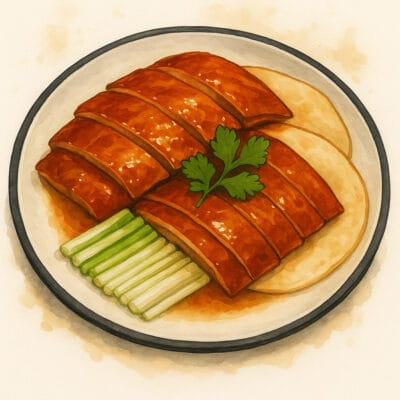Pato de Pequim (Peking Duck)
O pato de Pequim é a obra-prima culinária mais celebrada da capital chinesa, com origens que remontam à Dinastia Yuan. O prato foi aperfeiçoado durante a Dinastia Ming, tornando-se um dos pilares do menu imperial. Este prato icónico representa o auge das técnicas de assado chinesas, usando patos especialmente criados que passam por um processo de preparação meticuloso para alcançar a pele crocante e a carne suculenta que o caracterizam. O pato de Pequim não é apenas uma refeição, é uma experiência teatral, servida à mesa em fatias finas e acompanhado de panquecas, cebolinho, pepino e molho hoisin, que juntos criam uma experiência gastronómica memorável.
Pato de Pequim

Aprenda a fazer em casa o icónico Pato de Pequim, com a sua pele crocante e a carne suculenta, ideal para uma refeição especial.
Ingredients
- 1 pato inteiro (1,8 kg), fresco ou completamente descongelado
- 2 chávenas de água
- 3 colheres de sopa de mel
- 1 limão, cortado em 4 fatias
- 3 colheres de sopa de molho de soja escuro
- 150 ml de vinho de arroz ou xerez seco
- 10 cebolinhos
- 1/2 chávena de molho hoisin
- Panquecas chinesas (para servir)
Directions
- Limpe o pato por dentro e por fora, e seque-o bem. Remova a glândula de óleo da cauda e apare as pontas das asas.
- Esfregue o pato com sal por todo o lado e recheie a cavidade com as fatias de limão, gengibre e cebolinhos.
- Para preparar o glacê, ferva a água com o mel, o molho de soja e o vinho de arroz. Mexa até dissolver o mel e deixe a mistura arrefecer.
- Pendure o pato num local fresco e seco por 24 horas para secar completamente a pele. Este passo é crucial para a pele crocante.
- Pré-aqueça o forno a 180°C. Pincele o pato com o glacê e leve ao forno.
- Asse o pato por 2-3 horas, virando a cada 45 minutos, até que a pele esteja crocante e dourada.
- Retire o pato do forno e deixe-o descansar por 10 minutos antes de fatiar a pele e a carne.
- Sirva imediatamente com as panquecas chinesas mornas, cebolinho cortado em juliana, tiras de pepino e molho hoisin.
A chave para um autêntico Pato de Pequim é a pele incrivelmente crocante. O passo de secar o pato ao ar livre é essencial, pois remove a humidade da pele, permitindo que ela fique estaladiça no forno. Pode usar um ventilador para acelerar o processo. O glacê não apenas adiciona sabor e cor, mas também ajuda a pele a caramelizar. Para o corte, a pele deve ser fatiada separadamente da carne e servida por cima, para uma experiência de sabor e textura ideal.
Nutrition
Por porção (aprox. 300g): 600 calorias; 40 g de gordura; 25 g de carboidratos; 35 g de proteína; 150 mg de colesterol; 1200 mg de sódio.
Peking Duck
Peking Duck is Beijing’s most celebrated culinary masterpiece, with origins dating back to the Yuan Dynasty. The dish was perfected during the Ming Dynasty, becoming a staple of the imperial menu. This iconic dish represents the pinnacle of Chinese roasting techniques, using specially bred ducks that undergo a meticulous preparation process to achieve the signature crispy skin and succulent meat. Peking Duck isn’t just a meal; it’s a theatrical experience, carved tableside and served with thin pancakes, scallions, cucumber, and hoisin sauce, which together create a memorable dining experience.
Peking Duck

Learn how to make the iconic Peking Duck at home, with its crispy skin and succulent meat, ideal for a special meal.
Ingredients
- 1 whole duck (4 lbs / 1.8 kg), fresh or completely thawed
- 2 cups water
- 3 tbsp honey
- 1 lemon, cut into 4 slices
- 3 tbsp dark soy sauce
- 5 oz rice wine or dry sherry
- 10 green onions scallions
- 1/2 cup hoisin sauce
- Chinese pancakes (for serving)
Directions
- Clean the duck inside and out, and pat it dry thoroughly. Remove the oil gland from the tail and trim the wing tips.
- Rub the duck all over with salt and stuff the cavity with the lemon slices, ginger, and scallions.
- To prepare the glaze, boil the water with the honey, soy sauce, and rice wine. Stir until the honey dissolves and let the mixture cool.
- Hang the duck in a cool, dry place for 24 hours to completely air-dry the skin. This step is crucial for crispy skin.
- Preheat the oven to 180°C (350°F). Brush the duck with the glaze and place it in the oven.
- Roast the duck for 2-3 hours, turning every 45 minutes, until the skin is crispy and golden.
- Remove the duck from the oven and let it rest for 10 minutes before carving the skin and meat.
- Serve immediately with warm Chinese pancakes, julienned scallions, cucumber strips, and hoisin sauce.
The key to an authentic Peking Duck is the incredibly crispy skin. The air-drying step is essential, as it removes moisture from the skin, allowing it to become crackling in the oven. You can use a fan to speed up the process. The glaze not only adds flavor and color but also helps the skin caramelize. For carving, the skin should be sliced separately from the meat and served on top for an ideal flavor and texture experience.
[/recipe-nutrition]
Per serving (approx. 300g): 600 calories; 40 g fat; 25 g carbohydrates; 35 g protein; 150 mg cholesterol; 1200 mg sodium.
[/recipe-nutrition]